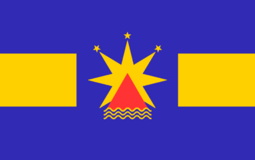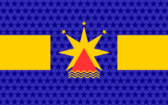Flag of the Calderan Republic: Difference between revisions
mNo edit summary |
mNo edit summary |
||
| Line 5: | Line 5: | ||
| Nickname = The Calderan flag | | Nickname = The Calderan flag | ||
| Use = 111000 | | Use = 111000 | ||
| Symbol = {{FIAV|111110}} {{FIAV| | | Symbol = {{FIAV|111110}} {{FIAV|normal}} | ||
| Proportion = 10:19 | | Proportion = 10:19 | ||
| Adoption = December 6th, 1944 | | Adoption = December 6th, 1944 | ||
Revision as of 12:01, 29 September 2023
 | |
| Name | The Calderan flag |
|---|---|
| Use | National flag |
| Proportion | 10:19 |
| Adopted | December 6th, 1944 |
| Design | Three stripes, alternating blue and yellow, penetrated by the seal of Austro-Caldera, consisting of a red triangle on a yellow octogram with 3 yellow stars at the highest points and 3 wavy yellow lines at the lowest points |
| Designed by | Issaque Chienne |
 Variant flag of State of Austro-Caldera | |
| Use | State flag |
| Adopted | December 9th, 1945 |
 Variant flag of State of Austro-Caldera | |
| Use | Military Naval ensign |
| Adopted | December 9th, 1945 |
The national flag of the State of Austro-Caldera, also referred to as the Calderan flag or the Austro-Calderan flag, consists of a 3 striped flag penetrated by an octagram with 3 stars at its highest point, a triangle in the middle, and 3 wavy stripes below the triangle to represent the sea.
History
The first Calderan flag, a version of the modern Volkspartei flag with the Calderan seal in the center, was used from 1585 until the Volkspartei took over in 1600. After taking over Austro-Caldera, the Volkspartei used their party flag (equivalent to their modern flag) to represent the entire country. This caused some civil unrest as Indigeno-Calderans felt like the Volkspartei was purposely excluding them from the Gothic population. When Volin movements began to arise in the late 1650s, the indigenous population would use a simple 3 striped flag, alternating blue and yellow, similar to the modern national flag without the seal, this was called the "Nuyak" (Volin: beautiful land), and was the basis for the modern national flag. In 1735, the Nuyak flag fell out of popular use as the flag of Bavogia was used to represent Volins instead.
After the Second Great War, the Volkspartei decided that Caldera needed to adopt a more peaceful flag that represented all people, especially Volins, to honor their sacrifices during the war. On December 6th, 1944, Prime Leader Issaque Chienne presented his design to the Volkshaus for selections, showing how he had defaced the Nuyak flag with the seal, which represents the island spirit of Caldera, with the red triangle representing the Volkspartei in control of Nuyak. Many Volkspartei members agreed that while it was a good flag to quell the native population and represent the whole land, they needed a better government flag to separate people in power from the natives. 3 days later, 2 flags were proposed for this purpose. A flag with a massive background of blue stars, and a flag with a background of gold stars. Unable to decide which to be the state flag, the Volkshaus came to a conclusion. The blue stars would be the state flag, while the gold stars would be the naval ensign, used to denote military vessels at sea.